

Biosafety concerns for labs in the developing world. F.
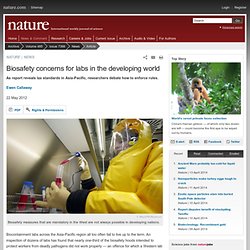
May/DPA/Newscom Biosafety measures that are mandatory in the West are not always possible in developing nations. Biocontainment labs across the Asia-Pacific region all too often fail to live up to the term. An inspection of dozens of labs has found that nearly one-third of the biosafety hoods intended to protect workers from deadly pathogens did not work properly — an offence for which a Western lab could be shut down. In one facility, only a shower curtain enclosed a table on which the brains of rabid dogs were routinely dissected. Such deficiencies are symptomatic of a biosafety crisis in many of the laboratories that diagnose and study infectious agents in developing countries, say biorisk experts who attended a meeting at London’s Chatham House on 17 May, where the results of the inspection were presented. Lightfoot believes that “you’re going to have dual standards” to cover different areas.
HS42_1F. Bird-flu research: The biosecurity oversight. The packages that started arriving by FedEx on 12 October last year came with strict instructions: protect the information within and destroy it after review.
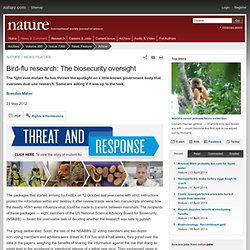
Inside were two manuscripts showing how the deadly H5N1 avian influenza virus could be made to transmit between mammals. The recipients of these packages — eight members of the US National Science Advisory Board for Biosecurity (NSABB) — faced the unenviable task of deciding whether the research was safe to publish. The group deliberated. Soon, the rest of the NSABB's 22 voting members and two dozen non-voting members and advisers were drawn in. Internal displacement at a glance (as of Dec 2011) Skip to main content Print 21 May 2012 Internal displacement at a glance (as of Dec 2011) Map fromInternal Displacement Monitoring Centre Published on31 Dec 2011 Download PDF (983.39 KB) Featured Primary country World Theme: Protection and Human Rights Content format: Map Language: English Vulnerable groups:
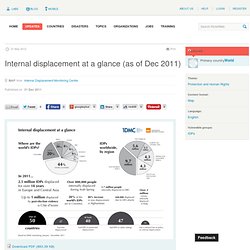
What price a slowing population? A Research Strategy for Environmental, Health, and Safety Aspects of Engineered Nanomaterials. Overview Authors Committee to Develop a Research Strategy for Environmental, Health, and Safety Aspects of Engineered Nanomaterials; National Research Council Description.

Geisinger Health Systems: What Are The Gas Drilling Health Facts? PITTSBURGH -- Some people are absolutely sure gas drilling threatens public health, while others are absolutely sure it doesn't.

Geisinger Health Systems is looking for more facts on the debate. "Our concern is getting reliable data so we know what to do for our patients," said David Carey, director of Geisinger's Weis Center for Research in Danville, Pa. Geisinger serves many patients who live in areas that have seen a recent boom in Marcellus Shale gas drilling. The gas-rich formation thousands of feet underground has generated jobs, billions of dollars and concerns about possible environmental and public health impacts from thousands of new wells. "There's a real need for reliable information for policymakers," Carey said, yet some of the debate on the issue has been more emotion-driven than science-driven. "Lack of data has not led to a lack of opinion," Carey noted. "Our position is, let's collect the data and find out," he said.
Ancient Diseases of Human Ancestors. I’ve written before about ancient diseases of the ice age, but this time I’m going even further back in time, to diseases that were present in the first human-like hominids.
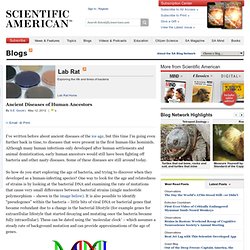
Although many human infections only developed after human settlements and animal domistication, early human ancestors would still have been fighting off bacteria and other nasty diseases. Some of these diseases are still around today. So how do you start exploring the age of bacteria, and trying to discover when they developed as a human-infecting species?
One way to look for the age and relatedness of strains is by looking at the bacterial DNA and examining the rate of mutations that cause very small differences between bacterial strains (single nucleotide polymorphism – shown in the image below). Image by David Hall (Gringer). The disease leprosy, caused by Mycobacteria leprae, has recently undergone this analysis and raised some interesting questions about its origins and spread. Malaria surge feared. J.
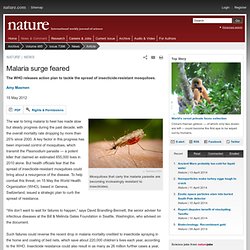
Gathany/CDC Mosquitoes that carry the malaria parasite are becoming increasingly resistant to insecticides. The war to bring malaria to heel has made slow but steady progress during the past decade, with the overall mortality rate dropping by more than 25% since 2000. A key factor in this progress has been improved control of mosquitoes, which transmit the Plasmodium parasite — a potent killer that claimed an estimated 655,000 lives in 2010 alone. Facing the Reality of Drug-Resistant Tuberculosis: Challenges and Potential Solutions in India: Summary of a Joint Workshop by the Institute of Medicine, the Indian National Science Academy, and the Indian Council of Medical Research.
Overview Authors Steve Olson, Rebecca A.
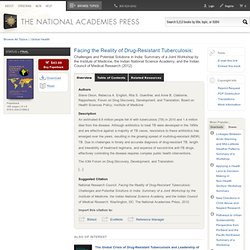
English, Rita S. Guenther, and Anne B. Claiborne, Rapporteurs; Forum on Drug Discovery, Development, and Translation; Board on Health Sciences Policy; Institute of Medicine Description An estimated 8.8 million people fell ill with tuberculosis (TB) in 2010 and 1.4 million died from the disease. The IOM Forum on Drug Discovery, Development, and Translation.